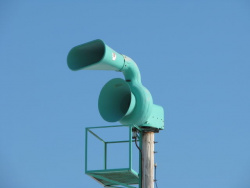Allertor 125: Difference between revisions
mNo edit summary |
|||
| Line 10: | Line 10: | ||
The Allertor 125 is a [[rotating]] siren produced by [[Alerting Communicators of America]]. The Allertor is one of it's kind as it intakes air through the bottom horn, and blows it out the top horn, which had never been an engineering design up until that point. Another strange design was a chain driven rotator, which was proved to be extremely faulty. Even a simple rust or un-lubricated part of a chain rotator could snap out of place. Allertors were also extremely heavy, and had an unsupported pole mount, which made it very prone to falling over. | The Allertor 125 is a [[rotating]] siren produced by [[Alerting Communicators of America]]. The Allertor is one of it's kind as it intakes air through the bottom horn, and blows it out the top horn, which had never been an engineering design up until that point. Another strange design was a chain driven rotator, which was proved to be extremely faulty. Even a simple rust or un-lubricated part of a chain rotator could snap out of place. Allertors were also extremely heavy, and had an unsupported pole mount, which made it very prone to falling over. | ||
== Rarities == | == Rarities == | ||
The siren came in 8/12, 9/12, and 10/12 port variations. The 8/12 and 10/12 versions are rare to find. The siren also came in | The siren came in 8/12, 9/12, and 10/12 port variations. The 8/12 and 10/12 versions are rare to find. The siren also came in single tone 8 or 12 port models, which are extremely rare. | ||
[[File:Rareallertor.jpeg|left|300px]] | [[File:Rareallertor.jpeg|left|300px]] | ||
Revision as of 02:10, 19 June 2019
| Allertor 125 | |
[[File: |200px]] |200px]]
| |
| Company | Alerting Communicators of America |
|---|---|
| Produced | 1968-1981 |
| Type | Electromechanical |
| Sound output | 125 |
| Documentation | Manual |
The Allertor 125 is a rotating siren produced by Alerting Communicators of America. The Allertor is one of it's kind as it intakes air through the bottom horn, and blows it out the top horn, which had never been an engineering design up until that point. Another strange design was a chain driven rotator, which was proved to be extremely faulty. Even a simple rust or un-lubricated part of a chain rotator could snap out of place. Allertors were also extremely heavy, and had an unsupported pole mount, which made it very prone to falling over.
Rarities
The siren came in 8/12, 9/12, and 10/12 port variations. The 8/12 and 10/12 versions are rare to find. The siren also came in single tone 8 or 12 port models, which are extremely rare.

History
The Allertor first became as a very strange idea brought up around 1945, ACA and many other civil defense companies were struggling to find reliable ways of alerting the public after WWII, as Russia had many threats to bomb and raid the United States. The Allertor 125 was inherited from the 10 HP siren which was called the Mobil-Directo, whose purpose was, according to Jim Biersach, "for use on remote island air bases in the Pacific Theater during World War Two." Later, when Biersach and Niedermeyer Co. reorganized into ACA, this idea was reintroduced and an electric powered, 10 HP siren inherited from the Mobil-Directo was later named the Allertor. Around 1960, the first prototype of an Allertor was produced. Early models were made of metal. This slowly grew their popularity as it was cheap to make. In 1968, the Allertor underwent a design change when its material was changed to fiberglass. Early models were made from a combination of metal and fiberglass; this was later changed to an all-fiberglass exterior and aluminum castings for the siren parts to eliminate the possibility of rust and corrosion; a design change that later proved successful and increased the sirens' longevity over ACA's competitors. This change in materials made the price increase dramatically, but nonetheless the siren was extremely popular. The Allertor lasted until 1982, where the P-10 would soon overcome the problems that the Allertor had, and would replace it.